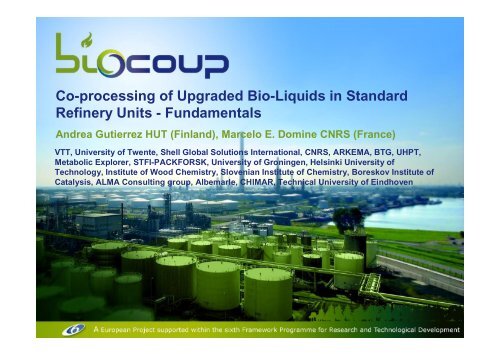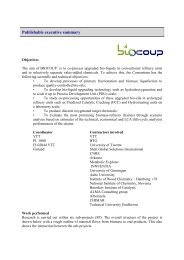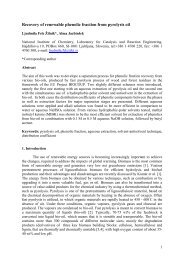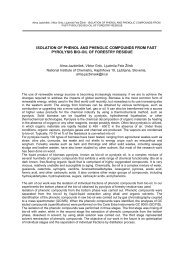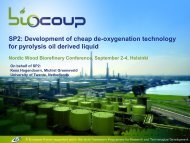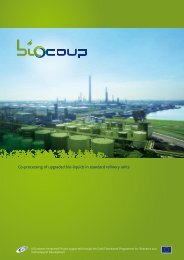Co-processing of Upgraded Bio-Liquids in Standard ... - Biocoup
Co-processing of Upgraded Bio-Liquids in Standard ... - Biocoup
Co-processing of Upgraded Bio-Liquids in Standard ... - Biocoup
Create successful ePaper yourself
Turn your PDF publications into a flip-book with our unique Google optimized e-Paper software.
<strong>Co</strong><strong>process<strong>in</strong>g</strong> <strong>of</strong> <strong>Upgraded</strong> <strong>Bio</strong><strong>Liquids</strong> <strong>in</strong> <strong>Standard</strong><br />
Ref<strong>in</strong>ery Units Fundamentals<br />
Andrea Gutierrez HUT (F<strong>in</strong>land), Marcelo E. Dom<strong>in</strong>e CNRS (France)<br />
VTT, University <strong>of</strong> Twente, Shell Global Solutions International, CNRS, ARKEMA, BTG, UHPT,<br />
Metabolic Explorer, STFIPACKFORSK, University <strong>of</strong> Gron<strong>in</strong>gen, Hels<strong>in</strong>ki University <strong>of</strong><br />
Technology, Institute <strong>of</strong> Wood Chemistry, Slovenian Institute <strong>of</strong> Chemistry, Boreskov Institute <strong>of</strong><br />
Catalysis, ALMA <strong>Co</strong>nsult<strong>in</strong>g group, Albemarle, CHIMAR, Technical University <strong>of</strong> E<strong>in</strong>dhoven
Abbreviations<br />
<strong>Bio</strong>oil, bioliquid<br />
Pyrolysis oil<br />
Fast pyrolysis<br />
Integrated<br />
pyrolysis<br />
Deoxygenation<br />
HDS<br />
FCC<br />
SRGO<br />
A generic term <strong>in</strong>clud<strong>in</strong>g all biomaterial derived liquids<br />
A liquid bi<strong>of</strong>uel produced by pyrolysis<br />
A concept, where residence time for (biomass) solids is<br />
<strong>in</strong> the order <strong>of</strong> a few seconds<br />
A concept, where fast pyrolysis is <strong>in</strong>tegrated to a<br />
fluidizedbed boiler<br />
Oxygen removal from primary biooil either by thermal<br />
treatment, hydrodeoxygenation (HDO), or<br />
decarboxylation (DCO)<br />
Hydrodesulfurisation (a ref<strong>in</strong>ery unit operation)<br />
Fluidcatalytic crack<strong>in</strong>g (a ref<strong>in</strong>ery unit operation)<br />
Straight run gas oil<br />
15th European <strong>Bio</strong>mass <strong>Co</strong>nference 711 May 2007 2
Distributed Procurement for <strong>Bio</strong>mass and<br />
Centralized Upgrad<strong>in</strong>g for Derived <strong>Bio</strong><strong>Liquids</strong><br />
<strong>Bio</strong>mass<br />
residues<br />
Petroleum<br />
ref<strong>in</strong>ery<br />
Deoxygenation<br />
Integrated Pyrolysis<br />
Motor<br />
fuels<br />
BIOCOUP started June 2006<br />
with 17 partners, duration five<br />
years<br />
The project is aimed at<br />
develop<strong>in</strong>g a cha<strong>in</strong> <strong>of</strong> process<br />
steps to allow a range <strong>of</strong><br />
biomass feedstocks to be cofed<br />
to a conventional oil ref<strong>in</strong>ery to<br />
produce energy and oxygenated<br />
chemicals.<br />
15th European <strong>Bio</strong>mass <strong>Co</strong>nference 711 May 2007 3
Overall <strong>Bio</strong>mass Process<strong>in</strong>g Cha<strong>in</strong><br />
Primary<br />
liquefaction<br />
.<br />
Deoxygenation<br />
<strong>Co</strong><strong>process<strong>in</strong>g</strong><br />
<strong>in</strong> petroleum<br />
ref<strong>in</strong>ery<br />
Chemicals<br />
The presentation will deal with fundamentals <strong>of</strong> two<br />
process steps <strong>in</strong> the cha<strong>in</strong><br />
•Deoxygenation <strong>of</strong> primary bioliquids (three<br />
variants studied, hydrodeoxygenation reported<br />
today)<br />
•<strong>Co</strong><strong>process<strong>in</strong>g</strong> <strong>in</strong> a petroleum ref<strong>in</strong>ery<br />
15th European <strong>Bio</strong>mass <strong>Co</strong>nference 711 May 2007 4
Properties <strong>of</strong> Wood Derived <strong>Bio</strong><strong>Liquids</strong><br />
<strong>Co</strong>mplex mixtures <strong>of</strong> oxygen conta<strong>in</strong><strong>in</strong>g compounds<br />
Mass %<br />
100<br />
80<br />
60<br />
40<br />
20<br />
0<br />
Watersoluble compounds<br />
P<strong>in</strong>e<br />
GUA<br />
Forest residue<br />
Aldehydes, ketones<br />
Acids<br />
'Sugars'<br />
Water<br />
Extractives<br />
LMM lign<strong>in</strong><br />
HMM lign<strong>in</strong><br />
Thermally unstable: No heat<strong>in</strong>g<br />
High polarity: Insoluble <strong>in</strong><br />
m<strong>in</strong>eral oils<br />
High molecular mass (HMM)<br />
compounds: High viscosity<br />
The properties can be improved<br />
by partial or complete elim<strong>in</strong>ation<br />
<strong>of</strong> oxygenated compounds<br />
15th European <strong>Bio</strong>mass <strong>Co</strong>nference 711 May 2007 5
Hydrodeoxygenation<br />
<strong>Bio</strong>liquids<br />
Hydrodeoxygenation<br />
(HDO)<br />
Catalytic reaction<br />
<strong>in</strong> presence <strong>of</strong> H 2<br />
Hydrocarbons + H 2<br />
O<br />
The composition <strong>of</strong> bioliquids makes HDO challeng<strong>in</strong>g…<br />
•Viscosity and solubility problems<br />
•Large amount <strong>of</strong> reactions<br />
•Analytical challenges<br />
Behavior <strong>of</strong> real<br />
bioliquids<br />
simulated with<br />
model compounds<br />
15th European <strong>Bio</strong>mass <strong>Co</strong>nference 711 May 2007 6
HDO –Lab Scale Results<br />
Guaiacol<br />
•Representative <strong>of</strong><br />
degraded lign<strong>in</strong> fraction<br />
•<strong>Co</strong>ke precursor<br />
Products<br />
•Hydrocarbons<br />
benzene, cyclohexane,<br />
toluene<br />
•Ocompounds<br />
phenol, cyclohexanol<br />
<strong>Co</strong>nversion and product<br />
ditribution (mol%)<br />
100<br />
90<br />
80<br />
70<br />
60<br />
50<br />
40<br />
30<br />
20<br />
10<br />
0<br />
X GUA<br />
NiMo<br />
<strong>Co</strong>Mo<br />
Total<br />
HCs<br />
200 250 300 350<br />
Temperature ( o C)<br />
Temperature affects GUA conversion and HDO products concentration<br />
•NiMo more active at T below 300 o C<br />
•<strong>Co</strong>Mo more HDO selective at the highest T tested<br />
15th European <strong>Bio</strong>mass <strong>Co</strong>nference 711 May 2007 7
What is Expected from HDO?<br />
Based on s<strong>in</strong>gle model compounds and mixtures<br />
•Better understand<strong>in</strong>g <strong>of</strong> HDO reactions<br />
•Selection <strong>of</strong> catalysts<br />
Test<strong>in</strong>g <strong>of</strong> exist<strong>in</strong>g catalysts and development <strong>of</strong> new<br />
ones (active metal and support material)<br />
•Selection <strong>of</strong> operation conditions for <strong>in</strong>dustrial scale<br />
HDO<br />
15th European <strong>Bio</strong>mass <strong>Co</strong>nference 711 May 2007 8
Ma<strong>in</strong> Objectives <strong>in</strong> <strong>Co</strong> Process<strong>in</strong>g<br />
Viability <strong>of</strong> upgraded bioliquids co<strong>process<strong>in</strong>g</strong> <strong>in</strong> standard ref<strong>in</strong>ery units<br />
Petroleum Fractions<br />
<strong>Co</strong>nventional Ref<strong>in</strong>ery<br />
<strong>Upgraded</strong><br />
bioliquids<br />
<strong>Bio</strong>oils<br />
HDS Unit<br />
FCC Unit<br />
Automotive Fuels<br />
Petroleum Fractions<br />
•Technical feasibility <strong>of</strong> upgraded bioliquids co<strong>process<strong>in</strong>g</strong> (210 wt%)<br />
<strong>in</strong>: fluidized catalytic crack<strong>in</strong>g (FCC) units, and hydrotreat<strong>in</strong>g (HDS) units<br />
•Effect <strong>of</strong> bioliquids co<strong>process<strong>in</strong>g</strong> on key ref<strong>in</strong>ery unit parameters and<br />
necessary bioliquids specifications after upgrad<strong>in</strong>g (i.e. metals, water,<br />
oxygen and other heteroatoms)<br />
•Technical data on product yields to determ<strong>in</strong>e the contribution from the<br />
biocomponent (model compounds studies)<br />
15th European <strong>Bio</strong>mass <strong>Co</strong>nference 711 May 2007 9
Prelim<strong>in</strong>ary Result Hydrotreat<strong>in</strong>g<br />
Methodology:<br />
Investigation <strong>of</strong> the performances <strong>of</strong> <strong>Co</strong>Mo and NiMo on alum<strong>in</strong>a HDT<br />
catalysts <strong>in</strong> the conversion <strong>of</strong> a SRGO <strong>in</strong> a micropilot unit (40 bars, 320<br />
370ºC)<br />
1 stage : addition <strong>of</strong> model molecules<br />
2 stage : addition <strong>of</strong> upgraded bioliquids<br />
3 stage : <strong>in</strong>creas<strong>in</strong>g the amount <strong>of</strong> bioliquids<br />
Evaluation <strong>of</strong> the performances<br />
total sulfur content, density, 2D<br />
GC chromatography<br />
Guaiacol, napthol, benzoqu<strong>in</strong>one,<br />
isopropanol do not <strong>in</strong>hibit the<br />
conversion <strong>of</strong> the Scompounds<br />
and they are totally converted at<br />
320°C<br />
15th European <strong>Bio</strong>mass <strong>Co</strong>nference 711 May 2007 10
Prelim<strong>in</strong>ary Results –Fluid Catalytic<br />
Crack<strong>in</strong>g (FCC)<br />
Methodology:<br />
Simulat<strong>in</strong>g FCC labscale reactor at 530 ºC<br />
Effect <strong>of</strong> oxygenated compounds<br />
addition on the hydrocarbon (C 8<br />
)<br />
catalytic crack<strong>in</strong>g<br />
80<br />
Feed: Hydrocarbon (C 8<br />
) + 2 wt% oxygenates<br />
Catalyst: FCC eq. sample (1 g) Cat/Oil = 15<br />
Cycles <strong>of</strong> crack<strong>in</strong>g/stripp<strong>in</strong>g/regeneration/purge<br />
Hydrocarbon <strong>Co</strong>nversion (wt%)<br />
75<br />
70<br />
65<br />
60<br />
55<br />
50<br />
45<br />
40<br />
Initial<br />
Acetic Ac. Addition<br />
Acetone Addition<br />
isoPropanol Addition<br />
1 3 5 7 9<br />
Crack<strong>in</strong>g Cycles<br />
With 2 wt% <strong>of</strong> Oxygenates:<br />
<strong>Co</strong>nversion<br />
<strong>Co</strong>ke<br />
Selectivity (wt%)<br />
35<br />
30<br />
25<br />
20<br />
15<br />
10<br />
5<br />
0<br />
<strong>Co</strong>mparison <strong>of</strong> product<br />
distribution at isoconversion<br />
Light<br />
Gases<br />
Propylene<br />
isobutane<br />
Initial<br />
+ Acetone<br />
Butenes C5 C6C7<br />
15th European <strong>Bio</strong>mass <strong>Co</strong>nference 711 May 2007 11
What is Expected from <strong>Co</strong><strong>process<strong>in</strong>g</strong>?<br />
• Feed delivery systems for co<strong>process<strong>in</strong>g</strong><br />
• <strong>Co</strong><strong>process<strong>in</strong>g</strong> <strong>in</strong> HDS units: catalyst stability (with<br />
steam), product quality, process conditions<br />
• <strong>Co</strong><strong>process<strong>in</strong>g</strong> <strong>in</strong> FCC units: i) product distribution and<br />
quality (low coke, high selectivity to diesel, gasol<strong>in</strong>e or<br />
light olef<strong>in</strong>s, high quality <strong>of</strong> liquids products, good<br />
control gaseous emission, etc); ii) catalyst lifetime,<br />
hydrothermal stability, and possibility <strong>of</strong> regeneration.<br />
• <strong>Bio</strong>liquids specifications and special requirements for<br />
their adequate co<strong>process<strong>in</strong>g</strong> <strong>in</strong> ref<strong>in</strong>ery units<br />
15th European <strong>Bio</strong>mass <strong>Co</strong>nference 711 May 2007 12
Hydrodeoxygenation Directions<br />
•BIOCOUP will develop methods to, at least partially, deoxygenate<br />
the bioliquids before the f<strong>in</strong>al upgrad<strong>in</strong>g. This<br />
should improve the competitiveness <strong>of</strong> bioliquids upgrad<strong>in</strong>g;<br />
e.g. by reduc<strong>in</strong>g hydrogen consumption.<br />
•New catalyst will be developed for bioliquids HDO<br />
•Generate data need for scale up <strong>of</strong> the HDO unit (mixture <strong>of</strong><br />
model compounds and real bioliquids)<br />
15th European <strong>Bio</strong>mass <strong>Co</strong>nference 711 May 2007 13
<strong>Co</strong>Process<strong>in</strong>g Directions<br />
•Evaluation <strong>of</strong> the viability <strong>of</strong> upgraded bioliquids co<strong>process<strong>in</strong>g</strong><br />
<strong>in</strong> ref<strong>in</strong>ery units (HDS, FCC, and others)<br />
•Basic knowledge <strong>of</strong> the co<strong>process<strong>in</strong>g</strong> effect on key<br />
ref<strong>in</strong>ery units parameters<br />
•<strong>Bio</strong>liquids specifications for the adequate feed<strong>in</strong>g and co<strong>process<strong>in</strong>g</strong><br />
<strong>in</strong> ref<strong>in</strong>ery units (Study with real upgraded bioliquids)<br />
•Develop<strong>in</strong>g better, more robust catalysts by <strong>in</strong>creased<br />
understand<strong>in</strong>g <strong>of</strong> the reaction k<strong>in</strong>etics and the relationship<br />
with the catalyst structure.<br />
15th European <strong>Bio</strong>mass <strong>Co</strong>nference 711 May 2007 14
Acknowledgements<br />
BTG<br />
UT<br />
Shell Global Solutions<br />
RUG<br />
Albemarle<br />
STFI<br />
VTT<br />
HUT<br />
CNRSIRC<br />
ARKEMA<br />
METEX<br />
ALMA<br />
BFH<br />
UHPT<br />
CHIMAR<br />
Boreskov Institute<br />
<strong>of</strong> Catalysis<br />
SIC<br />
Scientific <strong>of</strong>ficers:<br />
Maria Georgiadou<br />
Philippe Schild<br />
Maria FernandezGutierrez<br />
15th European <strong>Bio</strong>mass <strong>Co</strong>nference 711 May 2007 15


